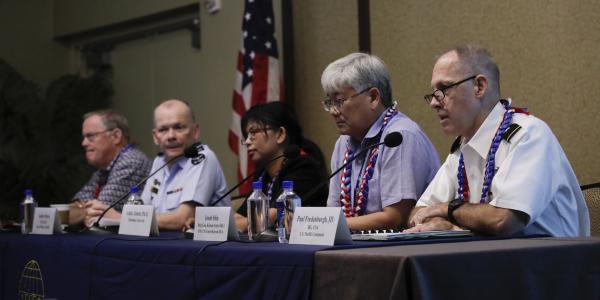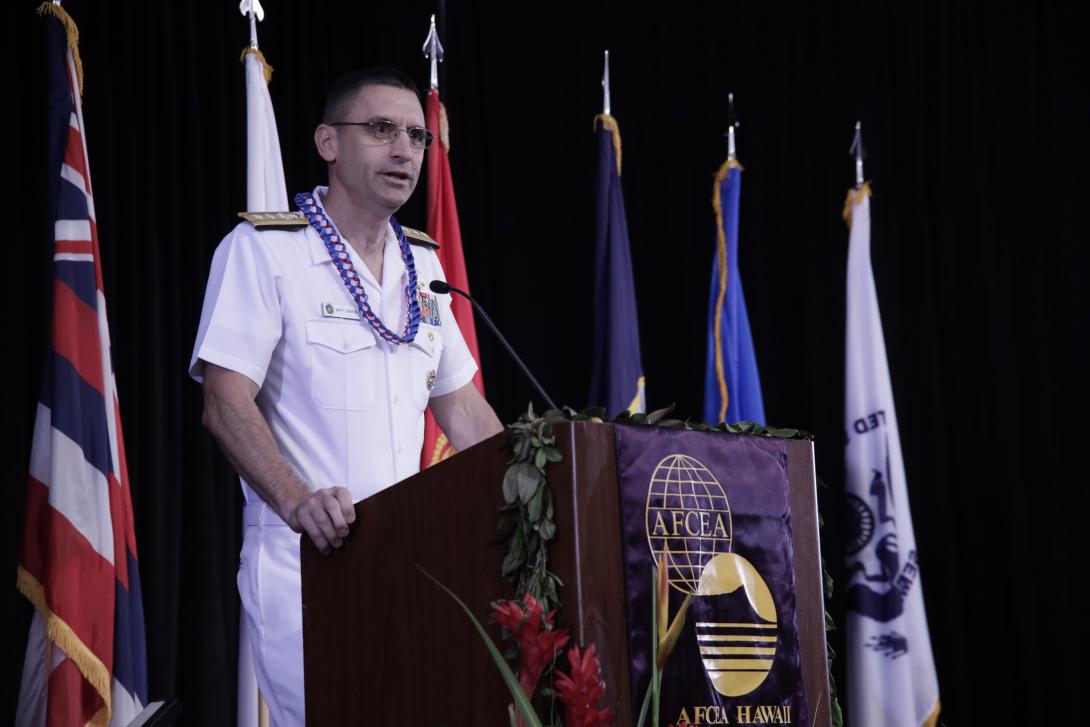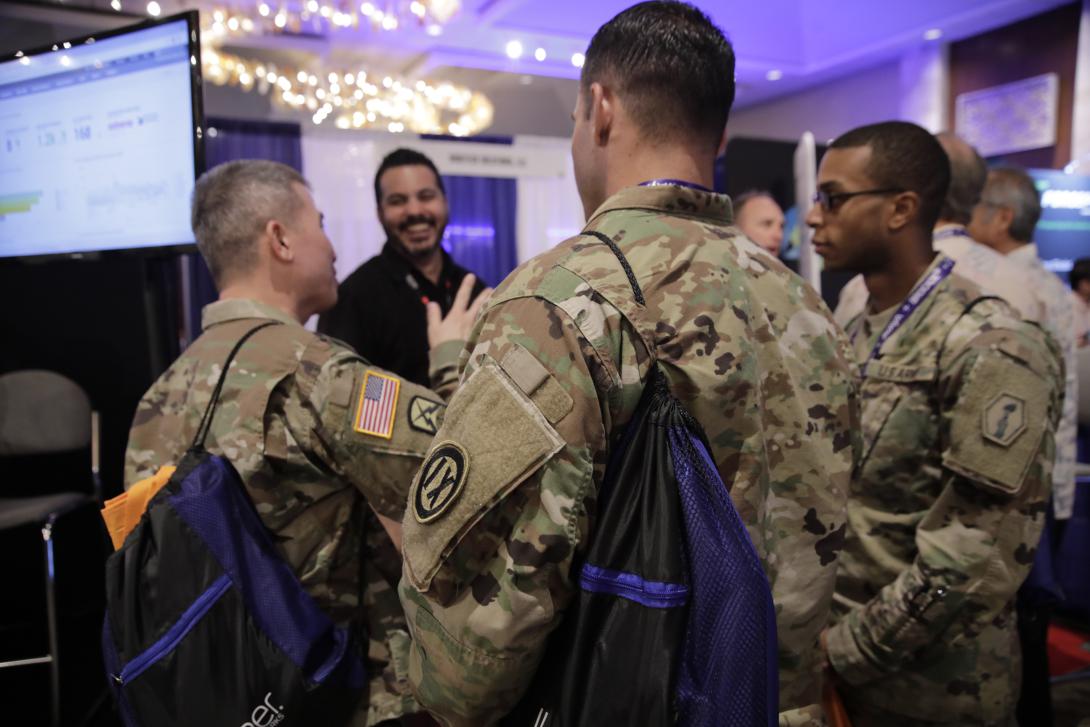Vast Pacific Region Has Big Responsibilities
Mission assurance and resilience can be interpreted differently, but having relevant tools and capabilities, developing solid multilateral partnerships and employing a trained work force are critical requirements for meeting many mission objectives. Equally important is the ability to convert data into actionable knowledge to support decision making in a way that can respond flexibly in a variety of scenarios.
Data is the most important thing, stated Terry Halvorsen, chief information officer and an executive vice president of Samsung Electronics. “The ones who win will be the ones who know how to extract value from aggregated data and put it into decision mode,” Halvorsen explained. He added that Americans have seen this play out with the election.
Both data and platform manipulation occurred through data streams designed to influence behavior. Think of what this could mean to the battle commander, he said.
The importance to commanders is clear. A pressing question they are trying to answer is how best to process raw data into actionable intelligence that operators can use to make decisions. “Information continues to grow and outpace our ability to process it,” noted Rear Adm. Matthew J. Carter, USN, deputy commander, U.S. Pacific Fleet.
In today’s big data environments, it is not that “we don’t know what we don’t know.” It is actually “we don’t know what we do know,” said Col. Pete Don, USA, deputy senior intelligence officer for intelligence operations, U.S. Army Pacific. “We are being dazzled with so much data that it is hard to focus and find the needle in the haystack.” The net seizes our attention only to scatter it, he contended.
Halvorsen, Adm. Carter and Col. Don were three of a number of leaders from industry, military, government and academia who discussed cyber operations for mission assurance and resilience in November at AFCEA’s TechNet Asia-Pacific.
The conference, held in Honolulu near the home of the U.S. Pacific Command (PACOM), addressed growing concerns about the region as well as the need to ensure continued peace. PACOM’s area of responsibility covers the Indo-Asia-Pacific region, including three of the largest economies and seven out of eight of the fastest-growing economies in the world. It also is home to seven of the 10 largest militaries, so this area shapes and contributes to global security in significant ways.
Lt. Gen. Bryan P. Fenton, USA, deputy commander, PACOM, said North Korea, ISIS and geographic volatility are three of the top challenges for his organization. “In only six years, Kim Jong Un has tested more missiles than his father and grandfather combined,” and more last year than in previous years, the general said. He emphasized that North Korea is evolving as a great security threat to the United States, its allies and the rest of the world.
“Diplomacy and economic pressure are the best path to success,” stressed Gen. Fenton, but military options are the backup to that. “We need to do everything possible to reach a peaceful solution, including pressure on China as a stakeholder. No nation or entity gets a pass from us,” he stated.
ISIS terrorism is increasing in Asia, Bangladesh and the Philippines, and “this is a threat that must be defeated,” Gen. Fenton said. “We know that the displaced terrorist will seek other places to go. And their leaders have told them that if they cannot fight in the Middle East, come to Southeast Asia and fight in the Pacific.”
The third challenge the general discussed was the geographic volatility of the region, which experiences 90 percent of all earthquakes in the world and is home to 75 percent of the planet’s volcanoes. While addressing geographic volatility is not a primary mission, he describes it as a key focus. “Our desire is to build the capabilities of allies and partners, so this is important to Adm. Harris and the Pacific Command team,” he said.
Partnerships play a vital role, from helping with disasters or terrorist incidents to maintaining peace and security in the world, Gen. Fenton said. “We need partnerships with a purpose,” he stated. “The world is interconnected and interdependent in ways unimaginable years ago.” Multilateral partnerships act as force multipliers for the good of the world, he suggested, adding that the command looks for opportunities to work together with partners on collaboration to support cybersecurity, mission assurance and resilience.
Actions are needed to improve interoperability and information sharing with mission partners, but such sharing has some built-in risk. However, “we are making progress on risk, and we talk about interoperability twice a year with our mission partners,” stated Brig. Gen. Paul H. Fredenburgh III, USA, director, Command, Control, Communications and Cyber (C4), PACOM. The key is to be as flexible as possible and work with standards, he said, adding that this is where we can find some freedom of maneuver.
Training the work force is another factor that will ensure mission success and resilience. “Through the systems we already have at hand, we have tools that can make sense of that data in a way that is better than our imagination,” said Capt. Dale C. Rielage, USN, director, Intelligence and Information Operations (N-2/N-39), U.S. Pacific Fleet. “We need to train up intelligence professionals with a varsity-level understanding of what’s possible.” Human and culture elements are as important as the systems on the technical side.
Social media, if given context, also can be a powerful tool, Col. Don said. Being able to tease out the context from tweets or other forms of social sharing would be helpful.
The low cost of entry to technology, including social media, presents the potential for what were near-peer adversaries in the past to become peer adversaries, and we need to be dedicated to staying ahead. Many speakers at the event stressed that this means the government and the military need to step up dialogue with industry while streamlining and expediting the acquisition process. A commitment from leaders to continue the dialogue with industry to find solutions to problems was reiterated throughout the conference.
Editor’s note: Our readiness to address near-peer competition will be the focus at West 2018, bringing together military, industry and government leaders February 6-8 at the San Diego Convention Center: www.westconference.org.
Photography by Bob Goodwin
For additional coverage, including photos and presentations, see event.afcea.org/TNAP17Archive.



Comments